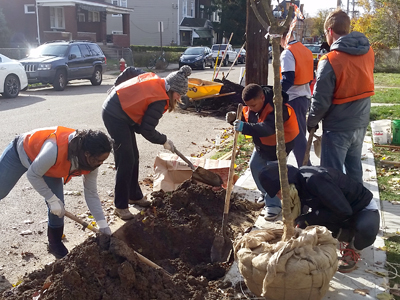Applying to TreeVitalize Pittsburgh
TreeVitalize Pittsburgh currently supports street tree plantings within Allegheny County and the City of Pittsburgh by providing forestry expertise, trees, supplies, and planting event coordination for neighborhood groups. TreeVitalize Pittsburgh also accepts applications for community parks and trails, and for restoration plantings.
The TreeVitalize Pittsburgh program’s street tree plantings help the Conservancy and its partners meet the goals of the City of Pittsburgh’s 10-year Street Tree Management Plan. The plan is based on tree inventory data collected in 2014 and helps guide our work to maintain and increase street tree populations. With the help of volunteers and partners, we do this work through new plantings, replacing trees that have been removed because of age or health reasons, and filling vacant tree planting sites.
Submitting an Application
*Final applications are due December 1, 2025

TreeVitalize Pittsburgh applications are being accepted now for the Spring 2026 tree planting season. To apply for TreeVitalize Pittsburgh, you must be an Allegheny County resident.
Contact Brian Crooks at bcrooks@paconserve.org or 724-840-0330 no later than October 1, 2025, to begin the application process. Brian can provide more in-depth information about the application process and will send the digital application to you.
After this initial contact, required site visits will be scheduled. Final applications are due December 1, 2025.
Interested in Planting Trees, but Live Outside of Allegheny County?
We encourage all residents from across the region to plant more trees! If you live outside of Allegheny County and wish to apply for trees for your community, please contact the statewide TreeVitalize grant program, managed by TreePennsylvania, for more information and to receive an application.
Find tips on seasonal tree care.
